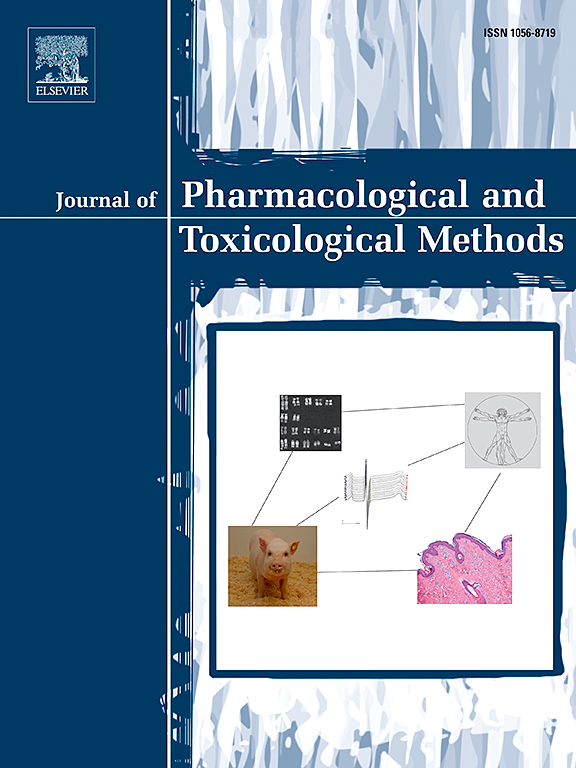有创与无创Wistar大鼠肾致石剂的比较研究
IF 1.3
4区 医学
Q4 PHARMACOLOGY & PHARMACY
Journal of pharmacological and toxicological methods
Pub Date : 2025-04-23
DOI:10.1016/j.vascn.2025.107743
引用次数: 0
摘要
由于多种因素,尿石症在人类和动物中已在全球范围内报道。如果合适的产石剂能复制人类所见的不同程度的严重程度,对尿石症的管理和治疗的研究将会受益。根据文献,乙二醇加氯化铵和草酸钠是大鼠常用的诱导肾结石的药物,但诱导期的持续时间在研究者之间存在差异。因此,在本研究中,乙二醇与1%氯化铵(EG1AC),乙二醇与2%氯化铵(EG2AC)在饮用水中持续14天,草酸钠(SO)以70 mg/kg体重通过腹腔给药14天,后监测长达50天,以了解肾脏损害。在尿石症模型的研究中,肾脏损害的严重程度是根据肾组织分析、尿液和血清参数来确定的。即时无创超声记分卡技术首次被用于评估尿石症患者肾脏损害的严重程度。根据尿、血清、肾组织及超声检查,草酸钠治疗肾结石1天就足够了,而EG1AC或EG2AC治疗7天,肾脏严重程度依次为草酸钠>;EG2AC祝辞第1 ~ 50天的EG1AC。超声记分卡可以有效地评估肾结石的形成和损害,而无需牺牲动物从第1天开始。本文章由计算机程序翻译,如有差异,请以英文原文为准。

A comparative study of kidney lithogenic agents in Wistar rats by invasive and noninvasive methods
Urolithiasis has been globally reported in humans and animals due to multiple factors. Research on the management and treatment of urolithiasis would benefit if suitable lithogenic agents replicate various degrees of severity as seen in humans. Based on the literature, ethylene glycol with ammonium chloride and sodium oxalate are the commonly used agents for the induction of kidney stones in rats, but the duration of the induction period varies between the researchers. Hence, in the present study, ethylene glycol with 1 % ammonium chloride (EG1AC), ethylene glycol with 2 % ammonium chloride (EG2AC) in drinking water for 14 days, and sodium oxalate (SO) at 70 mg/kg body weight administered through intraperitoneal route for 14 days and post monitored up to 50 days to know the kidney damage. In the studies on urolithiasis model, the severity of kidney damage is determined based on renal tissue analysis, urine, and serum parameters. For the first time, instantaneous noninvasive ultrasound scorecard technique has been used to assess the severity of kidney damage in urolithiasis. Based on the urine, serum, renal tissue, and ultrasound examinations, one day is enough for sodium oxalate for kidney stone formation, whereas seven days for EG1AC or EG2AC and the degree of kidney severity were in the order of sodium oxalate > EG2AC > EG1AC from days 1 to 50. Ultrasound scorecard can be effectively used to evaluate kidney stone formation and damage without sacrifice of animal from day 1 onwards.
求助全文
通过发布文献求助,成功后即可免费获取论文全文。
去求助
来源期刊

Journal of pharmacological and toxicological methods
PHARMACOLOGY & PHARMACY-TOXICOLOGY
CiteScore
3.60
自引率
10.50%
发文量
56
审稿时长
26 days
期刊介绍:
Journal of Pharmacological and Toxicological Methods publishes original articles on current methods of investigation used in pharmacology and toxicology. Pharmacology and toxicology are defined in the broadest sense, referring to actions of drugs and chemicals on all living systems. With its international editorial board and noted contributors, Journal of Pharmacological and Toxicological Methods is the leading journal devoted exclusively to experimental procedures used by pharmacologists and toxicologists.
 求助内容:
求助内容: 应助结果提醒方式:
应助结果提醒方式:


